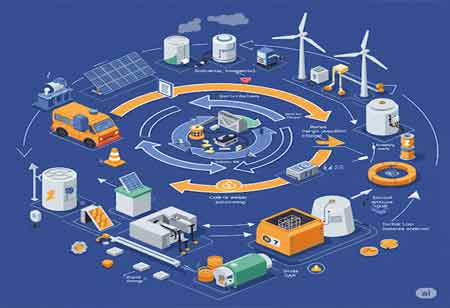Thank you for Subscribing to Energy Business Review Weekly Brief
How Circular Economy Principles Can Transform Energy Waste Management
Circular economy principles offer a sustainable path for energy waste management. They prioritize waste prevention, resource recovery, reuse, and recycling, leading to environmental and economic benefits.

By
Energy Business Review | Wednesday, May 28, 2025
Stay ahead of the industry with exclusive feature stories on the top companies, expert insights and the latest news delivered straight to your inbox. Subscribe today.
Fremont, CA: The current linear economy, with its 'take-make-dispose' model, is proving unsustainable on a global scale. This realization drives a significant shift towards a circular economy, a regenerative approach that keeps resources in use for as long as possible, minimizes waste, and regenerates natural systems. This transformation is particularly crucial in energy waste management, a sector grappling with increasing volumes and environmental concerns.
Transforming Energy Waste Management through Circularity
Applying circular economy principles to energy waste management can potentially drive transformative change across various stages of the energy lifecycle. Waste prevention and reduction are at the forefront, and they can be achieved through eco-design—developing energy infrastructure and components with extended lifespans, modular features for easy repair and upgrade, and using recyclable, non-toxic materials. For instance, solar panels designed for longevity and ease of repair can significantly reduce the frequency of replacements and the volume of associated waste. Moreover, advancements in waste-to-energy (WtE) technologies, such as gasification and pyrolysis, are emerging as efficient alternatives to traditional incineration, converting non-recyclable waste into valuable outputs like syngas for energy production or industrial feedstock, thus minimizing landfill reliance.
Latest Developments
Resource recovery and recycling are further enhanced by innovative technologies, particularly chemical recycling, which enables processing complex and contaminated materials such as multi-layer plastics often used in energy applications. Valuable materials can also be extracted from incineration ash, allowing metals and minerals to be reintegrated into manufacturing processes—for example, using bottom ash as a construction aggregate. As renewable energy systems proliferate, the end-of-life management of components like solar panels and wind turbine blades becomes increasingly critical. Companies invest in advanced recycling methods to recover materials such as silicon, aluminum, and rare earth elements, creating new secondary resource streams and supporting a circular energy economy.
Reuse and remanufacturing also play a vital role in minimizing waste. Energy equipment such as transformers can be refurbished and redeployed, extending their service life while reducing the need for new manufacturing. Remanufacturing processes—where components are disassembled, repaired, and rebuilt—offer significant resource and energy savings. Upcycling energy-related waste into higher-value products also presents new opportunities; for example, repurposing decommissioned wind turbine blades into construction materials or furniture exemplifies creative reuse.
Enabling technologies and systemic approaches are critical in optimizing energy waste management. AI and robotics are revamping material recovery, with AI-powered systems enhancing sorting accuracy and efficiency, optimizing logistics, and predicting maintenance needs to reduce operational downtime. Blockchain technology offers improved transparency and traceability in material flows, ensuring integrity in recycling processes. Consumer engagement is also elevated through gamified mobile applications, incentivizing responsible disposal behaviors. Furthermore, industrial symbiosis—whereby the waste or by-products from one process serve as inputs for another—can significantly enhance sustainability in the energy sector. Examples include reusing waste heat from power plants in adjacent industries or valorizing biofuel by-products in complementary sectors.
The principles of the circular economy offer a robust framework for transforming energy waste management from a linear "take-make-dispose" model to a sustainable and regenerative system. While infrastructure, technology, and policy challenges remain, the latest developments indicate a growing global commitment to embracing circularity in the energy sector. The need for supportive policies is urgent, and your role in advocating for these policies is crucial in realizing the full potential of a circular economy for energy waste management, paving the way for a more sustainable and resource-efficient future.






